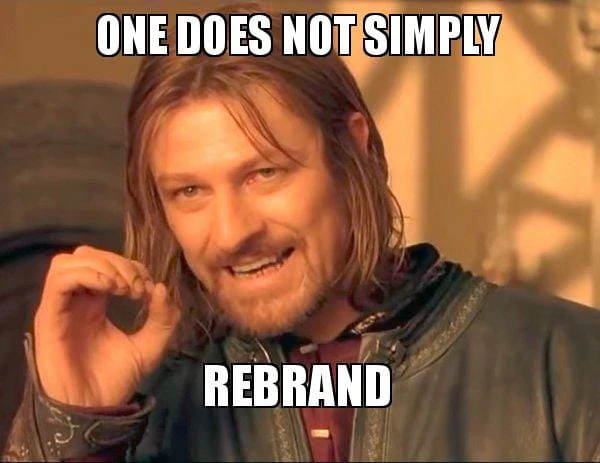You've just launched your new brand. The team is frothing with excitement. The reveal event was a hit. Your new logo looks fantastic, the website is live, and social media is filled with your fresh, vibrant visuals. Clients are commenting. Competitors are noticing. There's a palpable sense of momentum and possibility in the air.
Fast forward six months.
The excitement is gone. Old templates and messaging are sneaking into common use. Customer-facing teams are using the familiar talking points and phrases they are used to and there’s outdated language in client communications. Regional offices have started creating their own adaptations of brand materials, each different from the others. Your brand guidelines document sits in a shared folder, unread since week two. The new templates are materials you invested in are going unused or under-utilised. Your brand lacks consistency and cohesion and your staff walk by the poster on the wall of your new company values, but couldn’t actually name them.
Employees who believe in your brand are up to 300% more productive than those who don't.
Sadly, this pattern emerges with remarkable consistency across businesses of all sizes. Companies invest significantly in creating powerful brand strategies and beautiful brand identities but underinvest in the systems, oversight, and expertise needed to maintain and implement them consistently and effectively. A slow, almost imperceptible brand erosion gradually undoes the very investment they were so excited about.

When Good Brands Go Bad
Most businesses treat brand as a one-time project. They create a logo, build a website, and consider it "done." Brand guidelines tell you what to do, but not how to do it. Teams may enthusiastically embrace the new brand during launch week, but without practical systems that make implementation simple, they inevitably drift back to familiar habits. The brand agency that guided your rebrand usually moves on to their next project and says ‘good luck’ as they hand you your new brand assets. Your internal teams understood the strategic thinking during the presentations, but applying those principles to new business challenges requires judgment calls they don't feel equipped to make.
None of these moments alone derails your brand, but collectively they create a compounding effect that slowly transforms your carefully crafted brand into something unintended and unremarkable.
The Cost of Bad Brand Management
These post-rebrand challenges aren't merely inconveniences. They represent significant business costs that often go unrecognised until they've accumulated substantial losses.
Studies show that businesses with inconsistent branding lose up to 23% in potential revenue compared to those maintaining brand consistency across all touchpoints. And your internal brand suffers too. Companies with poor branding pay 10% higher salaries to attract the same talent and 92% of employees would leave their current position to work for a company with a better brand reputation. Another study found that employees who believe in your brand are up to 300% more productive than those who don't.
The gap between brand creation and successful long-term implementation represents the greatest opportunity for competitive advantage.
Perhaps most painful is watching your substantial brand investment depreciate quickly. A proper rebrand represents a significant financial commitment—typically tens or hundreds of thousands of dollars depending on the size of the company. Without the right post-launch planning and strategic oversight, that investment begins losing value immediately. The strategy, positioning, and creative work remain valuable assets, but their impact diminishes every time they're implemented or interpreted incorrectly.
What Actually Works
While every business has unique needs, I've found these foundational elements are the difference between brands that gradually fade and those that grow stronger over time.
- Ongoing Oversight - Someone who can evaluate how effectively your brand is being implemented across all touchpoints and identify both immediate corrections and strategic opportunities.
- Systems - Systems that make consistency the path of least resistance. This could mean developing comprehensive templates for everyday communications, building user-friendly asset libraries, and establishing clear workflows for brand implementation. When staying on-brand becomes easier than going off-brand, consistency becomes more sustainable.
- Team Empowerment - Regular brand training sessions transform your team from passive recipients of brand rules into active stewards who understand the "why" behind the guidelines. When people understand how the brand serves business goals, they are better able to use it effectively.
- Brand Evolution - Strong brands aren’t static, they should continue to evolve based on market changes, new opportunities, and emergent customer needs.
Working with dozens of businesses on rebrands and ongoing brand management has shown me a clear pattern. The gap between brand creation and successful long-term implementation represents the greatest opportunity for competitive advantage. Companies that bridge this gap amplify their brand investment, turning their brand into a business asset that creates measurable returns.
Brand Matters - The Missing Piece
Seeing these patterns play out time and time again led me to developing a completely new service offering called the Brand Matters program to provide an option specifically for organisations that understand the value of consistent brand implementation but don't have the resources for a full-time brand manager.
The Brand Matters Program gives your internal teams ongoing strategic guidance, bringing a fresh outside perspective backed by a decade of hands-on brand leadership experience and all at a small fraction of the cost of a full-time brand manager.
If you're heading towards a rebrand, are in the midst of one, or are looking back at one that hasn't delivered the sustained impact you hoped for, I'd be happy to share more details about the Brand Matters Program and how it can help. Jump on a free no-obligation brand consult to discuss your needs further.
The strongest brands I've worked with treat their brand strategy not as a project with a finish line, but as an ongoing practice that requires attention, nurturing, and expertise. They recognise that consistency isn't about rules for rules' sake but about creating a cohesive experience that builds trust, recognition, awareness, and connection.
That’s how you build a brand that really matters.


